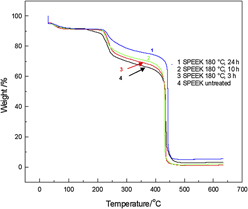Crossref Citations
This article has been cited by the following publications. This list is generated based on data provided by
Crossref.
Hou, Hongying
Di Vona, Maria Luisa
and
Knauth, Philippe
2012.
Building bridges: Crosslinking of sulfonated aromatic polymers—A review.
Journal of Membrane Science,
Vol. 423-424,
Issue. ,
p.
113.
Angst, Manuel
2013.
Ferroelectricity from iron valence ordering in rare earth ferrites?.
physica status solidi (RRL) – Rapid Research Letters,
Vol. 7,
Issue. 6,
p.
383.
Hou, Hongying
Polini, Riccardo
Di Vona, Maria Luisa
Liu, Xianxi
Sgreccia, Emanuela
Chailan, Jean-François
and
Knauth, Philippe
2013.
Thermal crosslinked and nanodiamond reinforced SPEEK composite membrane for PEMFC.
International Journal of Hydrogen Energy,
Vol. 38,
Issue. 8,
p.
3346.
Narducci, R.
Di Vona, M.L.
and
Knauth, P.
2014.
Cation-conducting ionomers made by ion exchange of sulfonated poly-ether-ether-ketone: Hydration, mechanical and thermal properties and ionic conductivity.
Journal of Membrane Science,
Vol. 465,
Issue. ,
p.
185.
Krishnan, N. Nambi
Henkensmeier, Dirk
Jang, Jong Hyun
Hink, Steffen
Kim, Hyoung-Juhn
Nam, Suk-Woo
and
Lim, Tae-Hoon
2014.
Locally confined membrane modification of sulfonated membranes for fuel cell application.
Journal of Membrane Science,
Vol. 454,
Issue. ,
p.
174.
Knauth, Philippe
and
Di Vona, Maria Luisa
2014.
Hydration and Proton Conductivity of Ionomers: The Model Case of Sulfonated Aromatic Polymers.
Frontiers in Energy Research,
Vol. 2,
Issue. ,
Doan, Jonathan
Kingston, Erin
Kendrick, Ian
Anderson, Kierstyn
Dimakis, Nicholas
Knauth, Philippe
Di Vona, Maria Luisa
and
Smotkin, Eugene S.
2014.
Theoretical and experimental infrared spectra of hydrated and dehydrated sulfonated poly(ether ether ketone).
Polymer,
Vol. 55,
Issue. 18,
p.
4671.
Di Vona, Maria Luisa
Sgreccia, Emanuela
Narducci, Riccardo
Pasquini, Luca
Hou, Hongying
and
Knauth, Philippe
2014.
Stabilized Sulfonated Aromatic Polymers by in situ Solvothermal Cross-Linking.
Frontiers in Energy Research,
Vol. 2,
Issue. ,
Di Vona, M.L.
Narducci, R.
Pasquini, L.
Pelzer, K.
and
Knauth, P.
2014.
Anion-conducting ionomers: Study of type of functionalizing amine and macromolecular cross-linking.
International Journal of Hydrogen Energy,
Vol. 39,
Issue. 26,
p.
14039.
Knauth, P.
Sgreccia, E.
and
Di Vona, M.L.
2014.
Chemomechanics of acidic ionomers: Hydration isotherms and physical model.
Journal of Power Sources,
Vol. 267,
Issue. ,
p.
692.
Ikeda, Naoshi
Nagata, Tomoko
Kano, Jun
and
Mori, Shigeo
2015.
Present status of the experimental aspect ofRFe2O4study.
Journal of Physics: Condensed Matter,
Vol. 27,
Issue. 5,
p.
053201.
Koziara, Beata T.
Nijmeijer, Kitty
and
Benes, Nieck E.
2015.
Optical anisotropy, molecular orientations, and internal stresses in thin sulfonated poly(ether ether ketone) films.
Journal of Materials Science,
Vol. 50,
Issue. 8,
p.
3031.
Zhang, Ming-Hua
Fan, Min-Min
Ma, Chao
Luo, Hui
Wu, Peng-wei
and
Zhang, Xi
2016.
Preparation of an oil-absorptive gel containing a 4-t-butyl styrene–EPDM–divinyl benzene graft polymer by reactive processing.
RSC Advances,
Vol. 6,
Issue. 106,
p.
104934.
Narducci, Riccardo
Chailan, J.-F.
Fahs, A.
Pasquini, Luca
Di Vona, Maria Luisa
and
Knauth, Philippe
2016.
Mechanical properties of anion exchange membranes by combination of tensile stress-strain tests and dynamic mechanical analysis.
Journal of Polymer Science Part B: Polymer Physics,
Vol. 54,
Issue. 12,
p.
1180.
Banerjee, Soma
and
Kar, Kamal K
2016.
Aluminum-substituted phosphotungstic acid/sulfonated poly ether ether ketone nanocomposite membrane with reduced leaching and improved proton conductivity.
High Performance Polymers,
Vol. 28,
Issue. 9,
p.
1043.
Pasquini, L.
Di Vona, M. L.
and
Knauth, P.
2016.
Effects of anion substitution on hydration, ionic conductivity and mechanical properties of anion-exchange membranes.
New Journal of Chemistry,
Vol. 40,
Issue. 4,
p.
3671.
Anderson, Kierstyn
Kingston, Erin
Romeo, Joseph
Doan, Jonathan
Loupe, Neili
Dimakis, Nicholas
and
Smotkin, Eugene S.
2016.
Infrared spectroscopy of ion-induced cross-linked sulfonated poly(ether ether ketone).
Polymer,
Vol. 93,
Issue. ,
p.
65.
Barbieri, G.
Brunetti, A.
Di Vona, M.L.
Sgreccia, E.
Knauth, P.
Hou, H.Y.
Hempelmann, R.
Arena, F.
Beretta, L.D.
Bauer, B.
Schuster, M.
Ossó, J.O.
and
Vega, L.F.
2016.
LoLiPEM: Long life proton exchange membrane fuel cells.
International Journal of Hydrogen Energy,
Vol. 41,
Issue. 3,
p.
1921.
Knauth, P.
Pasquini, L.
and
Di Vona, M.L.
2017.
Comparative study of the cation permeability of protonic, anionic and ampholytic membranes.
Solid State Ionics,
Vol. 300,
Issue. ,
p.
97.
Arias, Jose Jonathan Rubio
Carlos Dutra, José
and
Gomes, Ailton de Souza
2017.
Hybrid membranes of sulfonated poly ether ether ketone, ionic liquid and organically modified montmorillonite for proton exchange membranes with enhanced ionic conductivity and ionic liquid lixiviation protection.
Journal of Membrane Science,
Vol. 537,
Issue. ,
p.
353.
